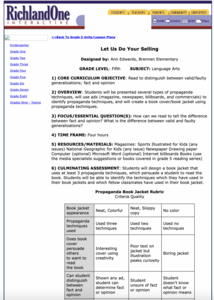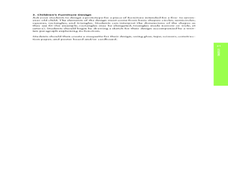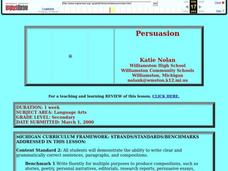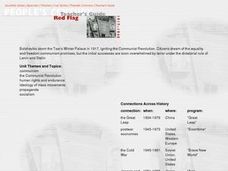Curated OER
High Exposure
Students interpret data they receive from the media, discuss possible misinterpretation of data from the media and correctly respond to the misconception quiz question.
Curated OER
Let Us Do Your Selling
Sixth graders analyze several types of propaganda techniques and create a book cover using the techniques. In this propaganda techniques lesson, 6th graders analyze the propaganda techniques used in various ads. Students analyze the...
Curated OER
Ideal Objects
Students make connections between two design objects intended for different purposes and analyze the social and political meaning in the designs. In this design analysis instructional activity, students complete image based discuss...
Curated OER
Understanding Life System: Growth and Changes in Plants
Third graders research ways in which plants are essential to humans. In this Global Peace lesson, 3rd graders participate in tasks, such as creating a propaganda poster. Students may watch the film, The Lorax, as a closing activity.
Curated OER
The Red Badge of Courage: A New Kind of Courage
High schoolers provide examples of Crane's treatment of the "manly virtues" associated with war using support from the text of The Red Badge of Courage. They describe the three published endings of The Red Badge of Courage and the...
Curated OER
Laurence of Arabia
Students critically examine the life and contributions of Lawrence of Arabia to the modern Middle East. They view a video on Laurence of Arabia. Students discuss the movie. Students create a propaganda posters or stories identifying...
Curated OER
Examine Persuasive Elements by Reading, Analyzing, and Discussing Persuasive Text
Students identify persuasive strategies and analyze arguments. In this persuasive writing lesson, students read "Chief Red Jacket's Reply" and "Reverend Cram's Speech to the Iroquois Nation" and chart major elements of each argument....
Curated OER
Causes of the Civil War: Missouri Compromise, Compromise of 1850 and Kansas Nebraska Act
How did the Missouri Compromise, the Compromise of 1850, and the Kansas-Nebraska Act contribute to the growing tensions that led to the Civil war? To better understand the events that led to the Civil War, young historians engage in a...
Curated OER
Art Imitates Life
Elementary and middle schoolers examine postcards depicting World War I events. Eventually, they create prints that reflect their own lives. In an interesting blend of history and current events, this lesson should engage your kids in...
Curated OER
Argumentative/Persuasive Writing
Intended for an intermediate/advance ELD course, this resource can support anyone learning the techniques and discernment needed for effective persuasive/argumentative writing. Beginning with the issue of curfews for a quick class...
Curated OER
I'm Convinced!
Learners examine persuasive techniques used to sell products, and create and write an advertisement for peanut butter.
Curated OER
Government
Second graders run for various offices. They dress up like a politician, pretend to be running for an office, and tell the students why they should vote for him/her. They explain why it is necessary for a community to have a government
Curated OER
Chemical Reactions with Vinegar
Fifth graders create their own volcano. In this science lesson, 5th graders build a "volcano" using vinegar and baking soda. They observe and analyze outcomes, and define a chemical reaction.
Curated OER
The Art of Political Cartoons in Revolutionary America
High schoolers analyze political cartoons. In this colonial America lesson, students examine the provided political cartoons and respond to analytical questions about each of them.
Curated OER
Rationalizing Race in US History
Young scholars consider the classification of people. In this race studies lesson, students examine the concept of race as it relates to U.S. history and trends. Young scholars research racial discrimination and prejudice in order to...
Curated OER
The Things They Carried by Tim O'Brien
In this online interactive reading comprehension worksheet, students respond to 13 multiple choice questions based on The Things They Carried. Students may submit their answers to be scored.
Curated OER
World War II Multimedia Newscast: History, Technology, Journalism
Students compose a multi-media newscast on various subjects relating to WWII to demonstrate their knowledge and ability to research.
Curated OER
Persuasion
Students explore the characteristics of a persuasive letter. They label each characteristic and they create a persuasive letter using the correct business letter format. Students recommend a school rule or change of a rule and justify...
Curated OER
YOUR OWN CAMPAIGN
Twelfth graders, in groups propose a new law and design a campaign to get people to vote for their law. They have a voter's forum and hold a mock election.
Curated OER
Double V Campaign: Victory at Home and Victory Abroad
Learners write a persuasive essay as if they were an African American in World War II and decide if they would contribute war bonds or not. In this World War II lesson plan, students study the segregation of World War II and the unity...
Curated OER
Compare the United States Government with Other Political Systems
Students explore the U.S. form of government and illustrate other forms of government found throughout the world. They explain the similarities and differences between the U.S and other governments.
Curated OER
Worksheet for Analysis of a Motion Picture
In this primary source analysis worksheet, learners respond to 14 short answer questions that require them to analyze the motion picture of their choice.
Curated OER
Communist Revolution
Young scholars examine the Russian Communist Revolution of 1917. They watch and discuss a video, take notes and answer video discussion questions, and read and evaluate newspaper articles about how Lenin and Stalin are viewed today in...
Curated OER
The Cold War in Popular Music
Learners analyze pop culture songs to identify cold war themes and chart. They comprehend and explain why the Cold War took place and ended and assess its significance as a 20th century event. Students conduct a song analysis of the...

























